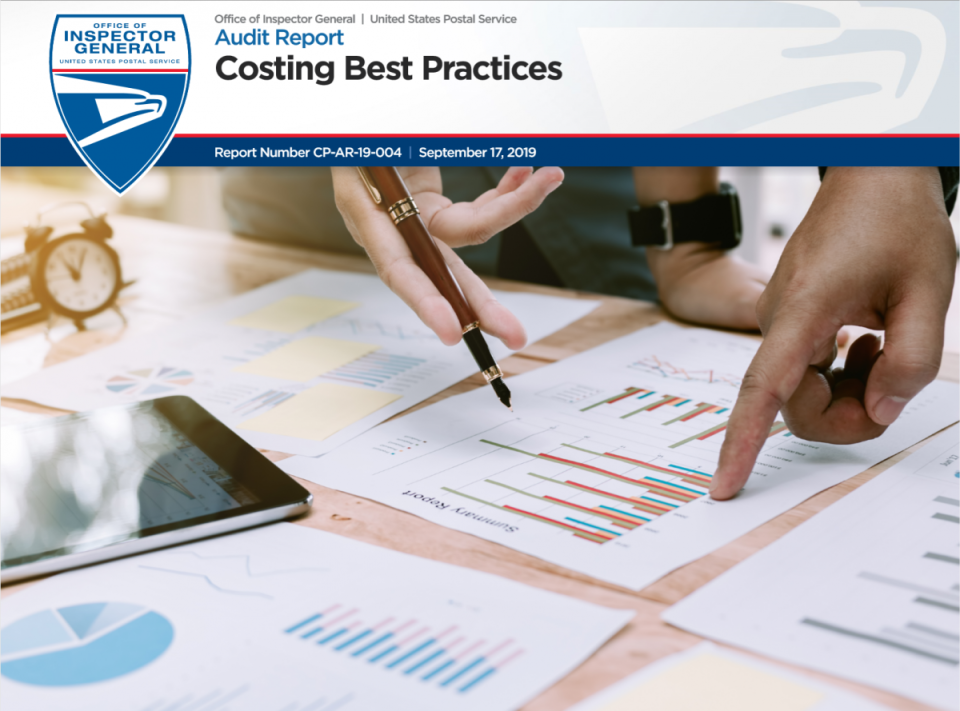Costing Best Practices
Objective
The U.S. Postal Service maintains a product costing system designed to comply with the Postal Accountability Enhancement Act (PAEA), develop product costs, and generate information to support management decisions. The PAEA requires the Postal Service to annually report costs, revenue, volume, and quality of service for products.
Its accounting systems do not generally provide the product-specific cost information required for reporting purposes; therefore, the Postal Service uses six statistical sampling systems and several special studies to generate the required regulatory reports. Supporting information essential to cost development is also obtained through information sources designed for operational purposes. The Postal Regulatory Commission (PRC) uses the information in these reports to determine whether the Postal Service complied with PAEA.
Our objective was to identify industry best practices for increased efficiencies in cost systems and methodologies.
What the OIG Found
The Postal Service should enhance its current costing processes to strengthen its costing data. Although the Postal Service’s costing methodologies meet regulatory requirements for reporting costing information, today’s mailing industry is increasingly competitive and dynamic and requires the use of more real-time data. Costing methodologies currently in place have historically relied on statistical sampling to assign annual or quarterly top-level costs to products. In 2018, the Postal Service reportedly spent about $26 million for its cost system manual data collection efforts. However, calculating and attaching granular costs at every step in the operational process, using census data, would strengthen costing data accuracy and reliability, and reduce costs associated with manual data collection for sampling.
Management stated that not all available census data are complete or accurate; however, they have conducted research over the last few years to identify opportunities to replace sampling data with census data. For example, management filed a petition with the PRC in 2016 to update its transportation cost model to replace some sample data with census data.
There are additional available opportunities to replace sampling data with census data. For example, during this audit we identified opportunities for the Postal Service to replace some outbound international mail sample data with third-party census data. Management agreed with our analysis and indicated they are currently working toward filing a methodological change with the PRC to replace some sample data with census data for outbound international mail.
In the past, we have issued other reports to the Postal Service regarding opportunities to modernize its current costing system. Our FY 2014 Greenfield Study detailed the potential benefits of replacing the current system with a modern, bottom-up costing and revenue analysis system. It also identified the difficulty in estimating the cost of developing a new cost system. Specifically, building a new cost system would require a financial commitment of millions of dollars, including investments in advanced technology to support the new system. During this audit, management agreed with this assessment, adding data accessibility and reliability concerns were another roadblock to updating the costing system.
In addition, in a FY 2018 report, we identified how using census data could capture additional mail processing components and provide more detailed, agile, and enhanced costing data. The existing cost model does not capture the costs of some mail operational activities. The OIG recommended the Postal Service develop a strategic plan to assess how current technology, such as using Intelligent Mail Barcodes and Informed Visibility, could be enhanced to better support costing.
Recent increases in the Postal Service’s use of automated data and enhanced technologies are removing barriers to developing a new, more granular costing system. Although the Postal Service has acquired technologies like using Intelligent Mail Barcodes and Informed Visibility to track domestic mail movement through the network, it has not yet fully leveraged these technologies to support the identification of product costs. Using data collection systems to continuously track products, especially parcels, from sender to recipient, would support accuracy in identifying costs, and assigning costs to products, both domestically and internationally.
A robust costing system should be capable of gathering costs for the flow of mail as they are incurred from the point of entry, acceptance, through processing, final delivery, returns, and invoicing. Enhancing its current cost system to include more granular, census data would increase the accuracy of the Postal Service’s cost attribution calculations, better support complex product and pricing decisions, and allow management to apply cost analysis to specific customers and/or specific areas. Additionally, the increased use of census data would help identify cost-reduction opportunities in the network. Lastly, changes to census data could reduce or eliminate labor costs associated with the collection of sample data by technicians.
What the OIG Recommended
We recommended management develop a plan with milestones to implement a modern costing system using enhanced technologies in an effort to incorporate cost attribution.

